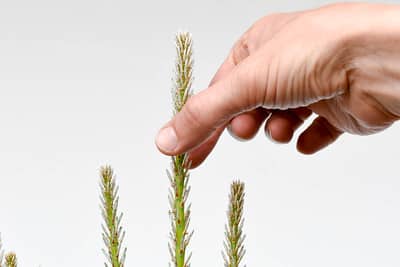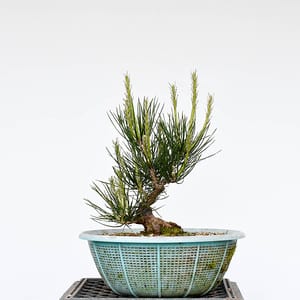The basic premise behind developing material for bonsai is straightforward: first build the trunk, then focus on the branches. When building the trunk, encourage vigorous growth to thicken the trunk rapidly. When focusing on branch development, encourage less vigorous growth to ensure good branch density. Sounds easy, but there may be a bit more to it than that. When making the transition from trunk development to branch development, many bonsai will be quite vigorous. What are some good strategies for decreasing vigor? A reduction of fertilizer sounds like a good idea, but reducing it too much can weaken trees. And when developing pines, it’s important to keep them strong enough to withstand decandling. Reducing sunlight or water is another strategy, but to keep trees healthy, plenty of sunlight and water are required. The main thing is to avoid over-watering at this stage as it can lead to excessively long needles. One way to slow down pines is to shorten the spring candles. After the candles begin to elongate, simply break off some portion of the candle with your fingers. How much to break off depends on how long the candles are. Here’s an example on an 11 year-old black pine.

11 year-old black pine
The idea for this pine is to make a small-sized bonsai. As the trunk has reached the desired size, I can pinch the longer candles to reduce the amount of food the pine produces.

First grab the section to be removed

Then snap it off
I shortened the longest candles on this pine by about half, but left the shorter candles alone.

After reducing the longest candles
I could have reduced the longer ones a bit more, but I didn’t want to remove too much foliage at this point as I’ll have another opportunity to balance vigor come decandling time. Do note, candle pinching is distinct from what is commonly referred to as decandling. Whereas decandling is the removal of fully developed shoots in spring, pinching refers to the partial reduction of candles before the needles elongate. Once pines are further developed, it’s more rare for extra-long candles to develop as the vigor is generally better balanced in more mature trees. When these long shoots do show up, I snap them off.
Today marks post #600 – thanks for reading!
Subscribe to Bonsai Tonight
New Posts Delivered Every Tuesday and Friday
ward says
Hello,
And thanks for the tips , i just have a question for you .. Do you have a post regarding the trunk thicken process? I’m a beginner and its hard to know when to make the cut in the trunk above the first branch to get the trunk to thicken.. and how to do it. I have a dwarf jade and a podocarpus and its unclear if they both backbud or if i should use other process?
Hoping you could me out.
Jonas Dupuich says
Hi Ward – the best info I can point you to on the topic is the following guide on black pines:
http://www.bssf.org/articles-and-stories/care-of-japanese-black-pine-stages-of-development/
The article does a good job describing the basic approach to trunk development for any variety.
zack Clayton says
Ward, Jade will backbud. If you pinch back growing tips aggressively, it will back bud a lot. I had a twin trunk specimen about 3″ caliper that took a dive during a storm – it is two healthy trees now and there was a lot of back budding even low on the trunks while they were recovering. Ohio, Zone 4-5 depending on the year, they are inside for the winter only.
Lee Squires says
Good job Jonas. I like your informative advice. I’m working on some Nishiki & Mikawa B.P. now and plan to let them grow this year and not pinch or needle pluck. I have them in 1 gal. Rootmaker plastic pots.
Lee
Dirk says
Congrats on #600! hope you go for at least another 600!!
ward says
Thanks for the info everyone , its hard for a beginner to determine when to cut the trunk.. Do you always do that after the summer? Or what do i have to look for? If i understand this link correctly i have to cut at november : http://www.bssf.org/articles-and-stories/care-of-japanese-black-pine-stages-of-development/
for a jade and podocarpus can you follow the advice from a pine? I mean cut the “candle”
Jonas Dupuich says
Hi Ward – how about posting a photo of the trees in question at http://ask.bonsaitonight.com/ and we can take it from there?